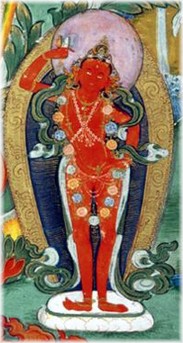Dakini: Difference between revisions
Jump to navigation
Jump to search
RyanConlon (talk | contribs) No edit summary |
RyanConlon (talk | contribs) No edit summary |
||
| Line 1: | Line 1: | ||
[[Image:Yumka.jpg|frame|]]'''Dakini''' (Skt. ''ḍākinī''; Tib. [[མཁའ་འགྲོ་མ་]], ''khandroma''; [[Wyl.]] ''mkha' 'gro ma'') — a female embodiment of enlightened energy. The ''[[Sarvabuddhasamayoga]] Tantra'' is one of the earliest sources to provide the etymology 'sky-goer' for the word ''ḍākinī'': | [[Image:Yumka.jpg|frame|]]'''Dakini''' (Skt. ''ḍākinī''; Tib. [[མཁའ་འགྲོ་མ་]], ''khandroma''; [[Wyl.]] ''mkha' 'gro ma'') — a female embodiment of enlightened energy. The ''[[Sarvabuddhasamayoga]] Tantra'' is one of the earliest sources to provide the etymology 'sky-goer' for the word ''ḍākinī'': 'Here the root is understood to be ''ḍai'', which expresses going in the sky; a '' 'ḍākinī' '' is known as the power (''siddhi'') of moving everywhere through space.'<ref>''Sarvabuddhasamāyogatantra'', i.9. See also Ratnakāraśānti, ''Guṇavatī'', NGMCP C 25-7, 1v.7; ''Sampuṭatantra'', I.iii.9cd-10ab. There are many variant readings of this verse; the above is based on the following text: ''ḍai vihāyagamane dhātur atra vikalpitaḥ | sarvākāśacarā siddhir ḍākinīti prasidhyati'' |</ref> Female [[lama]]s and the spiritual wives of male lamas often have the epithet 'khandro'. | ||
==Internal Links== | ==Internal Links== | ||
Revision as of 07:20, 20 June 2019

Dakini (Skt. ḍākinī; Tib. མཁའ་འགྲོ་མ་, khandroma; Wyl. mkha' 'gro ma) — a female embodiment of enlightened energy. The Sarvabuddhasamayoga Tantra is one of the earliest sources to provide the etymology 'sky-goer' for the word ḍākinī: 'Here the root is understood to be ḍai, which expresses going in the sky; a 'ḍākinī' is known as the power (siddhi) of moving everywhere through space.'[1] Female lamas and the spiritual wives of male lamas often have the epithet 'khandro'.
Internal Links
- ↑ Sarvabuddhasamāyogatantra, i.9. See also Ratnakāraśānti, Guṇavatī, NGMCP C 25-7, 1v.7; Sampuṭatantra, I.iii.9cd-10ab. There are many variant readings of this verse; the above is based on the following text: ḍai vihāyagamane dhātur atra vikalpitaḥ | sarvākāśacarā siddhir ḍākinīti prasidhyati |